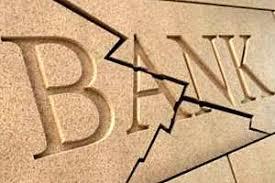Negative-Rates Bite: Bundesbank Fears Financial Stability Risks, Moody's Downgrades Outlook For German Banks
Authored by Nick Corbishley, for WOLF STREET,
Yield-starved banks expanded lending to “relatively high-risk businesses” and to the property sector, as the Bundesbank considers house prices in many cities overvalued by 15% to 30%.
The “risks to financial stability have continued to build up in Germany,” the Bundesbank warns in its Financial Stability Report, published this week. One major risk highlighted by the central bank is that Germany’s current economic slowdown — the result largely of “unfavourable external economic developments” — could turn into an “unexpected economic downturn”.
The country’s export-led economy has barely grown in the last five quarters as global trade has slowed. If the situation gets much worse, it could trigger a “deterioration in the debt sustainability of enterprises and households,” which in turn could lead to cascading loan defaults and credit write-downs.
Many yield-starved banks have significantly expanded their lending to “relatively high-risk businesses” while simultaneously reducing their provisions against losses on lending. As the Bundesbank puts it, “there are signs that banks’ lending portfolios now include a higher share of enterprises whose credit ratings could deteriorate the most in the event of an economic downturn.”
The banks are also heavily exposed to the fast-growing domestic real estate market, one of the few in Europe to have avoided a slump in the wake of the 2008 crisis. Since then, prices have surged as investors, domestic and foreign, have poured funds into real estate, and banks have shifted their focus toward property transactions.
Last year alone, house prices in Germany grew at an average rate of 8%. The Bundesbank estimates that property prices in German towns and cities are overvalued by between 15% and 30%. According to the 2019 Global Real Estate Bubble Index, housing in Munich is now the most overpriced in the world.
If the economy’s slowdown turns into a downturn, as the Bundesbank fears, Germany’s property boom could turn to bust, leaving investors, banks and developers shouldering large losses. Yet for now, surveys suggest that both households and lenders expect prices to continue rising long into the future. As the central bank notes, even as Germany’s macroeconomic situation deteriorates, the persistently low interest rates not only help to mask that reality, they provide ideal conditions for the financial vulnerabilities to grow further.
Moody’s picked up the cue and has downgraded its outlook for German lenders from “stable” to “negative” as profitability and creditworthiness deteriorate in a negative interest rate environment. Its report, published on Thursday, warned that the already weak profitability of German banks will decline further over the next 12 to 18 months.
“Banks’ weak profitability will decline further as net interest income falls,” the report said. German banks have been dogged by low levels of profitability. As of 2018, banks in the country had an average return on equity (ROE) of just 2.4%, the second lowest level in the EU after Greece and sharply lower than the EU average (6.1%).
There are two main things that set Germany’s banking system apart from the rest of the EU:
-
Its two biggest banks are struggling. Deutsche Bank, Germany’s largest bank, has notched up multiple quarters of heavy losses, has lost over 90% of its market value since 2007, and has faced numerous criminal investigations. Germany’s second largest lender, Commerzbank, was bailed out in the last crisis, is still partly state owned, and has seen its shares plunge in value by over 98% since 2007.
-
Germany is teeming with over a thousand unlisted savings banks and cooperative banks, which collectively account for over half of the banking system. These banks tend to be small, local and normally lend for productive purposes. Thanks to their prevalence, competition in Germany’s banking sector is more intense than in most other large developed economies, which translates into lower margins and profits. Many of these smaller lenders have borne the brunt of the ECB’s negative interest rate policy, which is as unpopular among the banks as it is among the country’s savers.
Even as the ECB pushed its deposit rate below zero, and as many bond yields have turned negative, customer deposits in Germany have continued to grow as most investors continue to shun equity investments. This has heaped yet further pressure on the banks’ already slender interest margins.
“Traditional commercial banks and in particular deposit-funded institutions will struggle to out-earn their costs in the continuing low interest rate environment, even though loan-loss provisions are unsustainably low,” Moody’s said. Even the ECB warned this week that falling bank profitability resulting from negative interest rates, which it itself is responsible for, poses one of the biggest threats to economic growth and financial stability in the region.
While many of Germany’s larger banks have passed on the cost of negative interest rates to their corporate clients, small banks, long accustomed to making money on the spread between the interest rate they pay on deposits and other funding sources, and the interest rate they charge on loans, realize that most of their retail customers won’t accept negative interest rates on their deposits. Rather than paying for depositing their funds or savings, those customers will yank their money out and put it elsewhere.
One tiny cooperative bank near Munich, Volksbank Furstenfeldbruck, took the leap this past week and became the first German lender to pass on the cost of negative interest rates to new retail customers with small deposits.
Meanwhile, the German government, in a bid to placate the country’s legions of long-suffering and increasingly irate savers, has even threatened to outlaw negative deposit rates altogether.
* * *
https://ift.tt/2XI1H8J
from ZeroHedge News https://ift.tt/2XI1H8J
via IFTTT





0 comments
Post a Comment